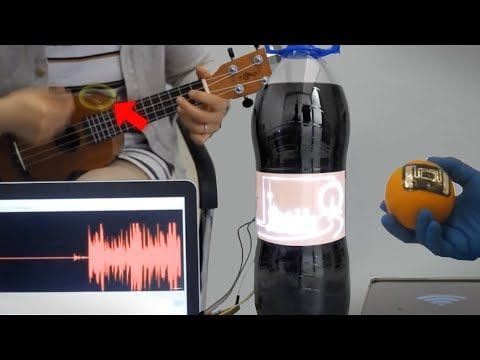This article is based on a recent paper published in ACS Applied Materials & Interfaces, “Thermal Transfer-Enabled Rapid Printing of Liquid Metal Circuits on Multiple Substrates.” Read the full paper here As electronics evolve, their component parts—including circuits—need to as well. New research published in ACS Applied Materials & Interfaces describes a method to print functional […]

This article is based on a recent paper published in ACS Applied Materials & Interfaces, “Thermal Transfer-Enabled Rapid Printing of Liquid Metal Circuits on Multiple Substrates.”
As electronics evolve, their component parts—including circuits—need to as well. New research published in ACS Applied Materials & Interfaces describes a method to print functional liquid circuitry on all manner of objects and surfaces—from smooth ceramics to the dimpled skin of an orange—using a standard laser printer.
Flexible Circuitry: Finding a Solution that Sticks
Most circuit boards used today are built with rigid materials, but as electronics become more widely incorporated in malleable products such as items of clothing or soft robots, there is now a greater need for flexible, low-cost circuitry. Liquid metal circuits have shown to be a promising solution, but current printing methods have proven to be both expensive and complex, rendering them impractical for large-scale production. Xian Huang and colleagues at Tanjin University in China began exploring a new printing approach in hopes of developing a cheaper, more efficient way of fabricating liquid metal circuits for use across many different materials.
While liquid metals have been used for a variety of applications in flexible materials and electronics, their high surface tension often leads to pattern distortion and weaker adhesive properties—making it difficult to successfully print directly on curved or uneven surfaces. To improve this process, the researchers presented a more universal technique for creating circuit patterns on thermal transfer paper using a standard desktop laser printer and Cu−Ag-EGaIn—a liquid metal obtained by melting silver−copper microparticles in a gallium−indium eutectic alloy.
Turning Any Surface Into a Circuit Board
Similar to iron-on decals for transferring photos or images onto clothing, the carbon-based toner was laid down by the laser printer and then heat-transferred to a pane of glass. The toner patterns roughened the glass and created a hydrophobic gap of air between the carbon and the Cu−Ag-EGaIn liquid metal, allowing only the exposed parts of the surface to stick to the electronic ink-based pattern when the liquid metal was brushed on top. The resulting circuit could then be mounted directly onto smooth surfaces, or, after applying a flexible polymer coating, onto rougher materials such as the bumpy skin of an orange.
Regardless of how they were attached, the simple electronics tested in the lab—which included LED displays, sound sensors, and radio-frequency identification (RFID) circuits—all functioned as intended on their underlying surfaces. These included wettable substrates such as thermoplastic polyurethane and glass as well as low-adhesion materials such as knitted fabric, paper, wood, and fruit. By demonstrating a cheaper, easier method of producing liquid metal circuits, this new technology has great potential to expand flexible circuitry across applications such as consumer electronics, health monitoring, wearable devices, and more.
Watch the video around this research created by the ACS Science Communications team:
Discover more research on liquid metals in ACS journals
- Kim, S. et al. Liquid-Metal-Coated Magnetic Particles toward Writable, Nonwettable, Stretchable Circuit Boards, and Directly Assembled Liquid Metal-Elastomer Conductors. ACS Appl. Mater. Interfaces 2022, 14, 32, 37110–37119
- Huang, C. et al. Soft and Stretchable Liquid Metal–Elastomer Composite for Wearable Electronics. ACS Appl. Mater. Interfaces 2022, 14, 33, 38196–38204
- Bhuyan, P. et al. Soft and Stretchable Liquid Metal Composites with Shape Memory and Healable Conductivity. ACS Appl. Mater. Interfaces 2021, 13, 24, 28916–28924
- Lopes, P.A. et al. Bi-Phasic Ag–In–Ga-Embedded Elastomer Inks for Digitally Printed, Ultra-Stretchable, Multi-layer Electronics. ACS Appl. Mater. Interfaces 2021, 13, 12, 14552–14561
- Choi, D.Y. et al. Highly Stretchable, Hysteresis-Free Ionic Liquid-Based Strain Sensor for Precise Human Motion Monitoring. ACS Appl. Mater. Interfaces 2017, 9, 2, 1770–1780

